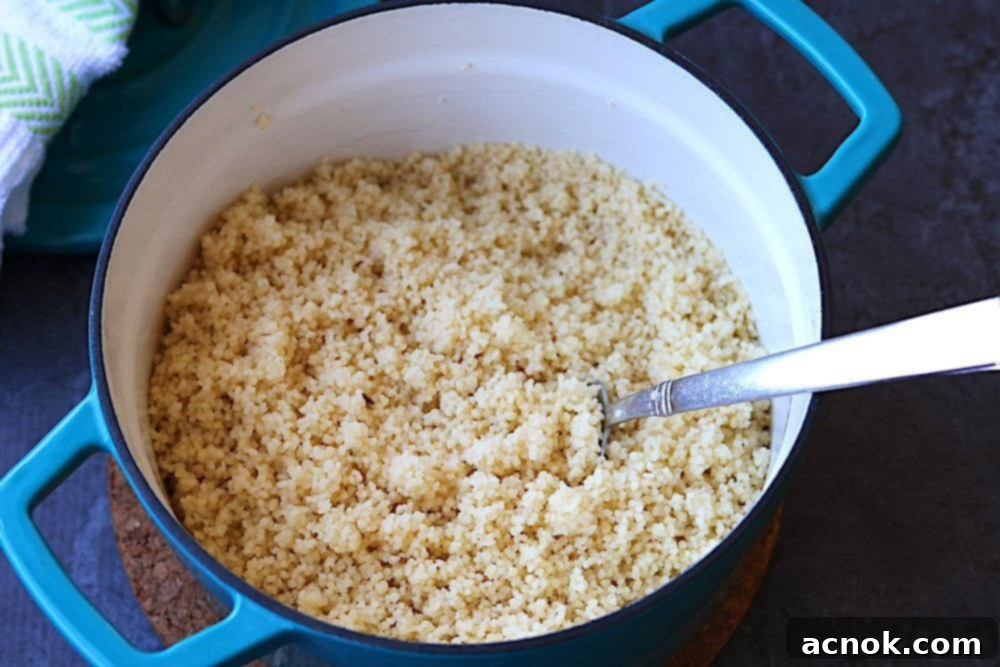How to Cook Perfect Fluffy Couscous Every Time: Your Ultimate Guide
Welcome to your definitive guide on cooking couscous! If you’ve ever struggled with mushy or clumpy results, today is the day you master the art of perfectly fluffy couscous. This incredibly simple, quick, and versatile side dish will become a staple in your kitchen, delivering a light, airy texture and absorbing flavors like a dream. Whether you’re pairing it with a rich stew, a grilled protein, or incorporating it into a vibrant salad, this recipe ensures flawless results every single time. Consider it a beautiful, blank canvas, ready for your culinary imagination!
What Exactly is Couscous? Grain or Pasta?
Before we dive into the cooking process, let’s clarify what couscous is. Often mistaken for a grain, couscous is actually a tiny, granular pasta made from semolina (durum wheat) that has been moistened and tossed with fine wheat flour until it forms small, uniform balls. Its origins trace back to the Berber people of North Africa, where it has been a dietary staple for centuries, typically served with savory stews and tagines. While the most common variety we encounter in Western supermarkets is made from durum wheat semolina, traditional couscous can also be made from other grains like pearl millet or sorghum, especially in different regions of Africa.
Because the widely available couscous is made from wheat, it naturally contains gluten. However, for those with gluten sensitivities or dietary preferences, gluten-free varieties made from corn, rice, or other grains are increasingly available in stores. Always check the packaging if you require a gluten-free option.
The Different Types of Couscous
Understanding the different types of couscous can help you choose the right one for your dish and adjust cooking times accordingly:
- Moroccan Couscous (Fine Couscous): This is the smallest and most common type, typically found in most grocery stores. It’s pre-steamed and dried, making it incredibly quick to prepare – often just needing a soak in hot liquid for a few minutes. This is the variety our recipe focuses on.
- Israeli Couscous (Pearl Couscous or Moghrabieh): Larger than Moroccan couscous, these are pearl-shaped pasta grains. They have a chewier texture and a slightly longer cooking time, often requiring simmering for 10-15 minutes, similar to rice or other pasta.
- Lebanese Couscous (Moghrabieh): The largest of the three, these are even bigger pearls than Israeli couscous, offering a very substantial and satisfying bite. They also take longer to cook, usually needing to be boiled until tender.
Our recipe today is specifically for the quick-cooking, fine Moroccan-style couscous, promising fluffy perfection with minimal effort.
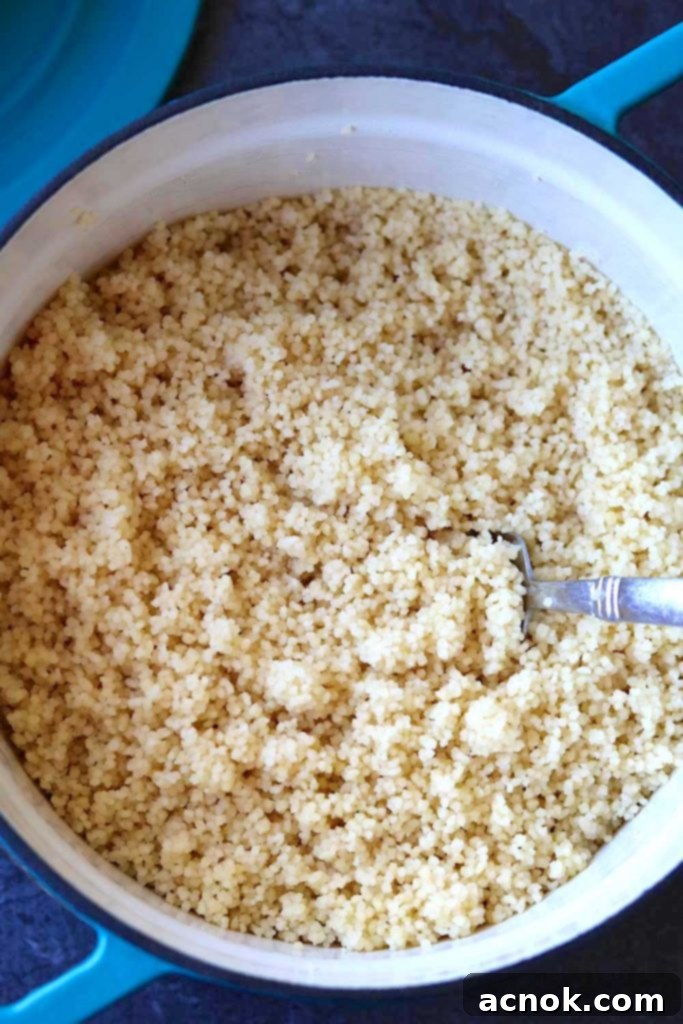
What You Need to Cook Perfect Fluffy Couscous
Gathering your ingredients and equipment before you start ensures a smooth and effortless cooking process. Here’s what you’ll need for our simple, foolproof couscous recipe:
- 1 small pot with a tight-fitting lid: Approximately 2 quarts is ideal for 1 cup of dry couscous. A snug lid is crucial for trapping steam and ensuring even cooking.
- 1 cup of couscous: We’re referring to the fine, quick-cooking Moroccan variety.
- 1 cup of water, chicken broth, or vegetable stock: The liquid is key! Broth or stock will infuse your couscous with more flavor than plain water.
- 1 tbsp of olive oil or butter: This adds richness and helps prevent the couscous from clumping, contributing to that desirable fluffy texture.
- Pinch of salt: Enhances the overall flavor. Kosher salt is often preferred for its clean taste.
- Pinch of pepper (optional): A touch of freshly ground black pepper can add a subtle warmth.
- Yield: This recipe yields approximately 3 cups of cooked couscous, perfect for 2-4 servings as a side dish.
Understanding the Couscous to Liquid Ratio
One of the most critical elements in achieving perfectly fluffy couscous is the correct liquid-to-couscous ratio. For fine Moroccan couscous, the golden rule is a simple **1:1 ratio**. This means:
- One cup of dry couscous requires one cup of liquid (water, broth, or stock).
- Two cups of dry couscous will need two cups of liquid.
- Following this precise ratio is essential for the couscous to absorb just enough moisture to become tender and separate without becoming soggy or gummy.
Using flavored broth or stock instead of plain water is a fantastic way to elevate your couscous, adding depth and richness that complements any main course. Consider vegetable broth for a vegetarian option or chicken broth for a more savory profile. You can also mix half water and half broth for a lighter flavor.
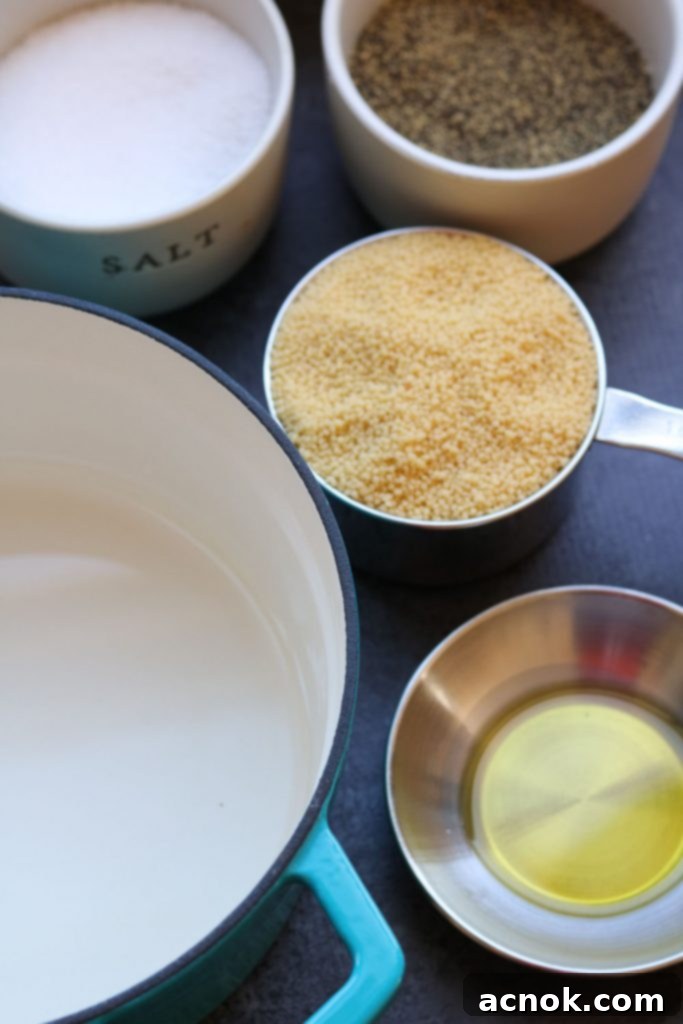
Step-by-Step Directions to Fluffy Couscous Perfection
Follow these straightforward steps, and you’ll be enjoying perfectly fluffy couscous in no time!
- Step 1: Prepare the Liquid. In your small pot with a tight-fitting lid, combine 1 cup of water (or broth/stock), 1 tablespoon of olive oil or butter, and a pinch of salt. If using, add a pinch of pepper now.
- Step 2: Bring to a Rolling Boil. Place the pot over medium-high heat and bring the liquid to a rapid, rolling boil. Watch it closely to ensure it doesn’t boil over.
- Step 3: Add Couscous and Cover. Once the liquid is boiling vigorously, immediately add 1 cup of dry couscous to the pot. Stir quickly with a spoon to ensure all the couscous is submerged and moistened. This only takes a few seconds.
- Step 4: Remove from Heat and Rest. Immediately place the lid tightly on the pot and remove it from the heat. It’s crucial that the pot is no longer on the burner; the residual heat will steam the couscous to perfection. Allow the couscous to rest undisturbed for exactly 5 minutes. Do NOT lift the lid during this time, as it lets the steam escape, which is vital for proper absorption.
- Step 5: Fluff for Perfection. After 5 minutes, remove the lid. Using a fork, gently fluff the couscous immediately. This separates the grains and prevents them from clumping together, creating that signature light and airy texture. Work the fork through the grains from the bottom up.
- Step 6: Serve and Enjoy! Your perfectly fluffy couscous is now ready to serve.
Pro Tip for Fluffiness: The fluffing step after the 5-minute rest is non-negotiable! Do it promptly and thoroughly to achieve the best texture. If left un-fluffed, the grains can stick together and become dense.
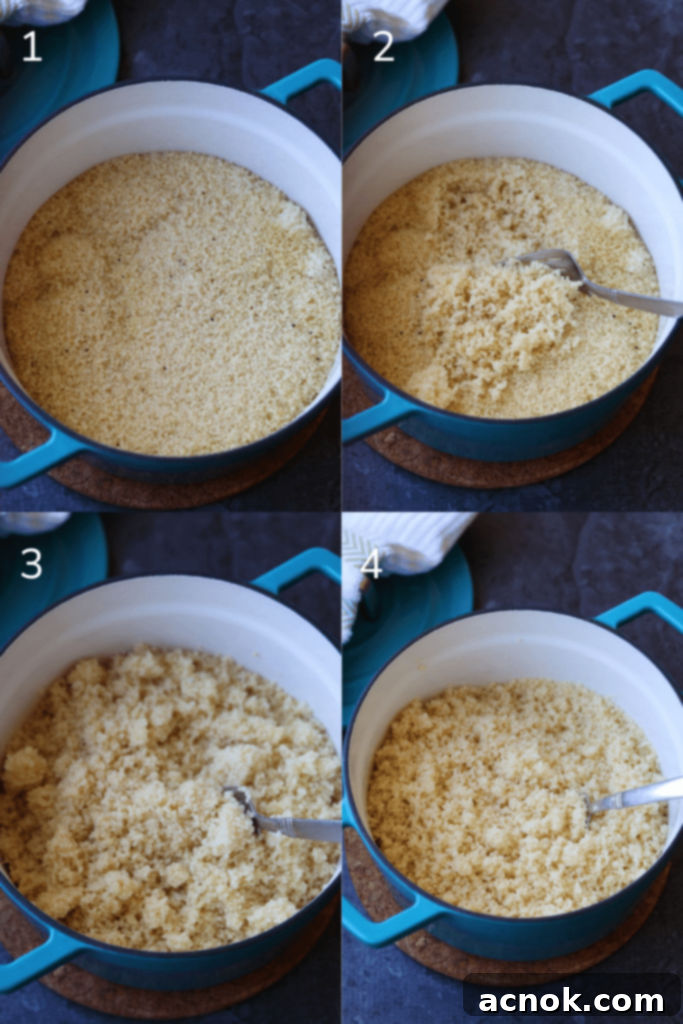
Elevate Your Couscous: Flavorful Variations and Serving Ideas
While plain couscous is a magnificent foundation, its neutral flavor makes it incredibly adaptable to a myriad of culinary creations. It’s the ideal canvas, ready to absorb and enhance any flavors you introduce. Here are some fantastic ideas to “level up” your couscous game, transforming it from a simple side into a star dish:
- Mediterranean Delight: Combine toasted walnuts, crumbled feta cheese, and fresh dill for a bright, savory, and textural explosion.
- Sweet & Savory: Try our delightful Couscous with Caramelized Onions and Feta – the sweetness of onions perfectly balances the salty feta.
- Italian Inspired: Stir in freshly grated Parmesan cheese and crunchy pine nuts for a rich and nutty twist. A sprinkle of fresh basil wouldn’t hurt!
- Zesty & Briny: Explore our refreshing Lemon Thyme Couscous with Olives for a vibrant, aromatic side.
- Green & Garlicky: Mix in cooked, finely chopped spinach, more crumbled feta cheese, and minced garlic for a wholesome and aromatic variation.
- Spicy Moroccan: Add a pinch of cumin, coriander, and a dash of cayenne pepper to the cooking liquid. Once fluffed, stir in chopped fresh cilantro and a squeeze of lime juice.
- Roasted Vegetable Medley: Toss the cooked couscous with a mix of roasted vegetables like bell peppers, zucchini, red onion, and cherry tomatoes for a hearty vegetarian meal.
- Herbaceous Freshness: Simply stir in a generous amount of fresh chopped herbs like parsley, mint, and cilantro along with a drizzle of extra virgin olive oil and a squeeze of lemon.
Don’t be afraid to experiment! Couscous pairs wonderfully with everything from grilled chicken and fish to lamb and hearty vegetable stews, such as our Rosemary Lemon Rack of Lamb with Couscous. Its subtle flavor allows it to complement, rather than overpower, your main course.
Frequently Asked Questions About Couscous
Here are answers to some common questions to help you confidently cook and enjoy couscous.
No, for the fine, quick-cooking Moroccan-style couscous, rinsing is generally not necessary. It’s already pre-steamed and dried, so it doesn’t have the excess starch that needs to be rinsed off like some other grains (e.g., rice). Rinsing might even make it clumpy.
Absolutely! Couscous is an excellent make-ahead side dish. Once cooked and fluffed, allow it to cool completely before transferring it to an airtight container. It can be stored in the refrigerator for up to 3-4 days. To warm it, place it in a microwave-safe dish and heat for about 1 minute, fluffing with a fork halfway through, or gently reheat on the stovetop with a tablespoon of water or broth to rehydrate it.
Yes, cooked couscous freezes beautifully! This is a great way to prepare extra portions for future meals. Allow the couscous to cool completely. Then, transfer it to freezer-safe zip-top bags, flattening them to remove air and for easy stacking. It can be frozen for up to 2-3 months. To defrost and reheat: Remove from the freezer, break off the desired portion (or the whole bag), and place it in a microwave-safe dish. Microwave for approximately 1-2 minutes, stirring and fluffing halfway through, until thoroughly heated through. You can also gently reheat it on the stovetop with a splash of liquid.
This usually happens if you used too much liquid or didn’t fluff it immediately after resting. Ensure you stick to the 1:1 ratio. If it’s a bit sticky, try spreading it thinly on a baking sheet to dry out slightly, then fluff again. For future attempts, make sure your lid is tight and you fluff it right away!
Yes, you can! Combine the couscous, liquid (1:1 ratio), oil/butter, and salt in a microwave-safe bowl. Cover tightly with a microwave-safe lid or plastic wrap and microwave on high for 2-3 minutes, or until all liquid is absorbed. Let it stand for 5 minutes, then fluff with a fork.
Couscous is a nutritious food, typically made from durum wheat semolina, which is a good source of complex carbohydrates, fiber, and protein. It also provides essential minerals like selenium. It’s a healthy alternative to white rice or pasta, especially when paired with fresh vegetables and lean proteins.
We hope this comprehensive guide empowers you to create perfectly fluffy couscous every time. It’s truly a game-changer for quick, delicious, and versatile meals.
If you tried this recipe and loved it, please help other readers by commenting below and sharing some stars! Your feedback means the world to us. We 🫶🏼 appreciate you!
All content and photographs ©Claudia’s Table and claudiastable.com
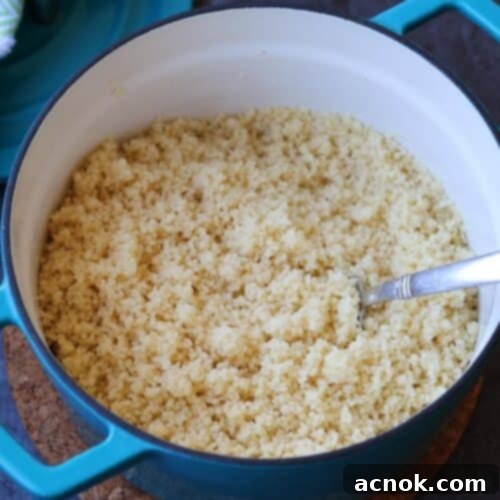
How to Cook Couscous
Ana | Claudia’s Table
August 30, 2020
Pin Recipe
5 minutes
5 minutes
Dinner, Side Dish
American, Mediterranean, North African
4
196
kcal
Equipment
-
1 small pot with a tight-fitting lid
2 quart
Ingredients
-
1
cup
of couscous -
1
cup
of water
chicken broth, or stock -
1
tbsp
of olive oil or butter -
pinch
of kosher salt -
pinch
of black pepper
optional
Prevent your screen from going dark
Instructions
-
Add 1 cup of water to the pan, add 1 tablespoon of olive oil or butter, add pinch of salt and pepper (optional)
-
Bring to a boil.
-
When the water starts to boil, add 1 cup of couscous, stir quickly, add the lid, and remove from heat.
-
Allow to rest for 5 minutes. Remove the lid and fluff the couscous immediately to prevent clumping.
-
TIP: Make sure you fluff the couscous after 5 minutes.
-
Now your couscous is ready to serve.
Notes
Nutrition
Serving:
0.75
cup
Calories:
196
kcal
Carbohydrates:
34
g
Protein:
6
g
Fat:
4
g
Saturated Fat:
1
g
Polyunsaturated Fat:
0.5
g
Monounsaturated Fat:
3
g
Sodium:
239
mg
Potassium:
72
mg
Fiber:
2
g
Sugar:
1
g
Vitamin A:
125
IU
Calcium:
10
mg
Iron:
0.5
mg
Nutritional information is calculated online and should be used as a guide.
easy couscous, how to cook couscous, how to cook fluffy couscous, ratio of couscous to water
All content and photographs ©Claudia’s Table and claudiastable.com
Share the Love on Pinterest
Follow
@claudiastable or pin for later !
